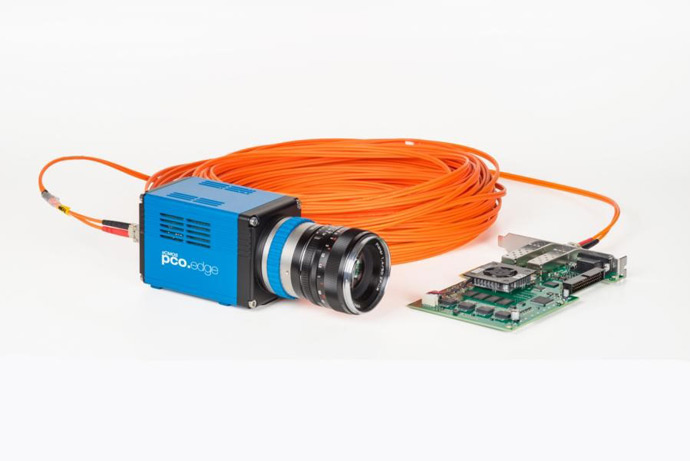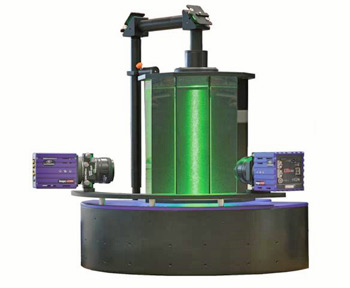Why PCO’s Camera Link HS is LaVision’s solution for high reliability requirements
In an interview Mr. Uwe Dierksheide – Product Manager at LaVision – provides an insight into different camera connection system and why PCO’s ultra-fast Camera Link HS (CLHS) interface is the system of choice in PIV (Particle Image Velocimetry) inspection. LaVision is a leading provider of innovative imaging laser measurement systems. The company’s standard systems as well as customer specified complete solutions are used in the fields of scientific and industrial optical metrology worldwide. LaVision is using pco.edge cameras with CLHS interfaces for PIV applications.

pco.edge camera with CLHS interface, cable and frame grabber
Photo by PCO AG
What is CLHS: A brief introduction.
CLHS is designed to specifically meet the needs of vision and imaging applications. It provides low latency, low jitter and real-time signals between camera and frame grabber. At the same time it carries image data, control data and trigger events. The interface builds upon the key strengths of Camera Link by adding new features and functions. CLHS is designed as a system ensuring that sCMOS sensor technology can be fully exploited. It provides cost effective cameras and frame grabbers that are easy to use, flexibility and data reliability demanded by customers. Several of PCO’s camera series like pco.edge and pco.dicam combine advanced sCMOS technology with an ultra-fast CLHS interface.
What are the benefits of PCO’s CLHS?
More bandwidth: Effective bandwidth of about 1187 MB/s (CLHS X-Protocol – 10G) equals roughly three times a USB 3.1 Gen1 bandwidth and netto data rate of CoaXPress CXP-12.
More robust connection:
- No communication error at a Bit Error Rate of 10 – 12 due to Forward Error Correction (FEC) algorithm
- FEC adjusts burst errors of up to 11 bits on the fly
- FEC technology supersedes packet resend mechanism for data reliability
- Fiber Optic Link provides high resistance to EMC
- Fiber Optic Link allows long cable lengths with the best signal integrity
More distance:
- Cable length more than 300 m using multi-mode fiber and more than 10 km with single-mode fiber.
More flexibility:
- Real-time trigger over cable with extremely low jitter
- Plug & Play with GenICam and GenCP
- Using standard LC-connector for flexible cable decision
More open:
- Full CLHS specification is downloadable for free
- AIA IP-core is available for fast compliant FPGA implementation (Xilinx, Altera, Lattice)
More cost effective:
- Use of standard network hardware components such as enhanced small form-factor pluggable (SFP+) connector from multiple vendors allows multi sourcing
- Inexpensive licensing
The Interview
Mr. Uwe Dierksheide, product manager and responsible for PIV (Particle Image Velocimetry) at LaVision, shared some insights with us on his company’s experience with this interface.
You are in the product management responsible for PIV systems at LaVision. Which data interfaces are you typically using in your applications? What technical requirements do the data interfaces need to meet?

Uwe Dierksheide, Product Manager at LaVision
Photo by LaVision GmbH
“In addition to the particle generator a PIV system usually consists of cameras with optics, lighting and a computer control unit for synchronization, data storage and analysis. The performance of the overall system depends to a high degree on how good these components are tuned to each other. Due to the development of higher resolutions and higher frame rates the requirements for data interfaces have risen dramatically within the last few years. While measuring the system often generates a huge amount of data in a very short time. This needs to be processed and stored as efficiently as possible. High-performing data interfaces with great reliability and high bandwidth are the key to the system’s overall efficiency.”
Which data interfaces do you currently use?
“At the moment we mainly use four types of data interface: USB 3 is a cost-effective solution available on nearly all computers as a standard feature. It is suitable for middle bandwidths. The length for passive cables, however, is limited to just a few meters. In addition to their network functionally we value Ethernet, especially 10GigE for their high bandwidth. The setup and operation of such a network with several cameras requires not only powerful individual components. Also a certain degree of system competence on the part of the users and administrators is necessary. In our high-performing systems we currently use either Camera Link or PCI Express. The bandwidths are extremely high. But on the other hand the cable lengths are very limited. Fiber optic converters with fiber optic cable can increase transmittance distance. However, this will also result in a rise in system complexity and costs.”
Why will you be using CLHS in the future?

pco.edge CLHS technology in one of LaVision’s typical PIV applications
Photo by LaVision GmbH
“From a technical point of view up to now the interface selection has always been a compromise between cable length and transmission rate. This compromise does not exist with the new CLHS. CLHS also meets our high reliability requirements. Thanks to the use of fiber optic cables EMV problems are a thing of the past. I would also like to point out the FEC which is integrated in the protocol. This additional security layer saves us from the worst case scenario: the loss of data.”
Aside from these technical arguments what is the profitability and cost efficiency of this new data interface?
“When comparing Camera Link with CLHS one would expect a higher price for CLHS due to its technical advantages. The truth is quite the opposite. The separate camera systems (camera, frame grabber and cable) are approximately the same price. However, we often have multi-camera setups with more than one camera per frame grabber and the omission of FOL converters in our applications. Therefore we are able to realize significant cost savings. The CLHS hardware is based on standard components from the network technology. There’s a huge market internationally for these components, independent of imaging applications with many hardware manufacturers. For this reason I’m convinced that the CLHS technology will also be well positioned in the future.”
Where do you see CLHS in three years?
“We will continue to use USB 3 and GigE for a long time. Nevertheless, CLHS is now our first choice for powerful peer-to-peer interfaces. I am positive this technology will establish itself successfully in the imaging market within the next years and replace Camera Link.”
For further information on LaVisions Services please visit: www.lavision.de
and for more Information and PCO’s cameras and components visit; www.pco.de
News Categories
- » NEWS HOME
- » Automation & Robotics
- » Industry 4.0
- » Material Handling
- » Sensors
- » Quality & Testing
- » Machine Vision
- » Laser & Optics
- » Metalworking
- » Motion Control & Drives
- » Hydraulics & Pneumatics
- » Process Industry
- » Renewable Energy
- » Agriculture
- » Home & Office Furniture
- » Environmental Tech

